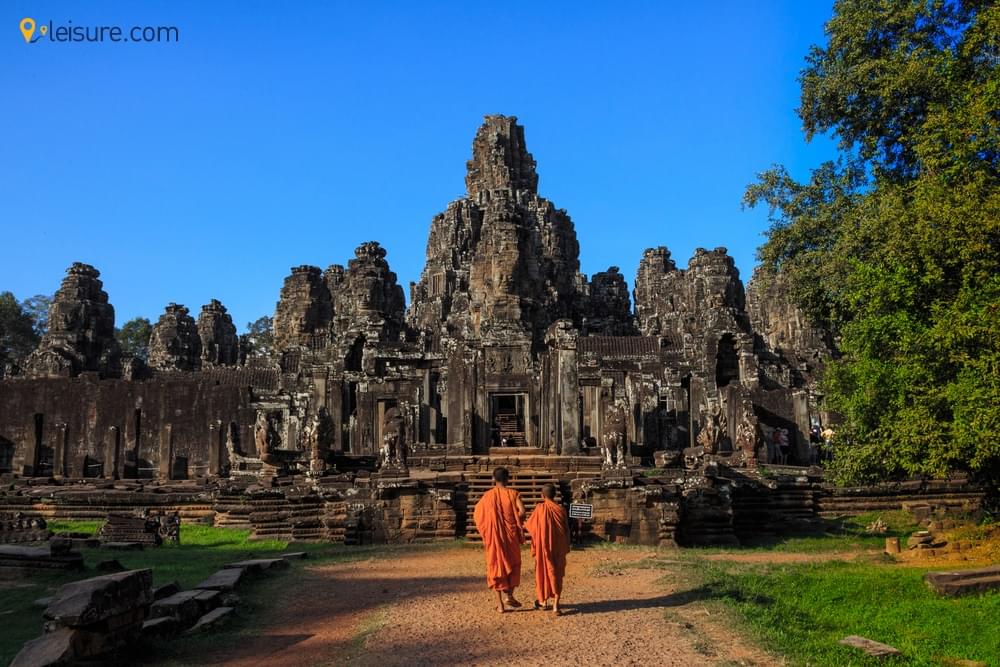Cambodia Tours
Starting a luxury Cambodia trip will allow you to fully experience an amazing vacation that effortlessly combines outstanding luxury, vivid culture, and historical legacy. Renowned for its amazing temples, calm countryside, and kind people, Cambodia is a gem of South-east Asia Ideal for a luxury Cambodia tour, the nation provides experiences ranging from the world-known Angkor Wat to boutique hotels, immaculate beaches, and busy towns like Phnom Penh.
Travellers can discover historic beauties, savour Khmer cuisine, and enjoy well chosen luxury experiences catered to their tastes. Cambodia offers adventure and leisure among a rich tapestry of history and culture. Luxury Cambodia tours offer comfort, discovery, and lifetime memories if you're looking for an amazing retreat.
With our Cambodia tours, which let history and culture come before your eyes, enter a world of awe. Starting with the UNESCO-listed Angkor Archaeological Park, a luxury trip in Cambodia transports you to the core of the nation's famous sites. Experience unlike any other at Angkor Wat as the sunrise paints the heavens above this great 12th-century temple. Nearby, the smiling stone faces of Bayon Temple and the tree-covered remains of Ta Prohm provide a window into Cambodia's legendary past.
Past Siem Reap, Cambodia boasts peaceful rivers, rich landscapes, and energetic cities. The vibrant metropolis, Phnom Penh, boasts luxury retail areas, historical buildings, and fine dining restaurants presenting world-class Khmer cuisine. The Mekong River cruises will provide peace to those looking for tranquilly since its breathtaking views and floating communities inspire the mind.
A Cambodia luxury tour guarantees every moment is unique whether one is visiting historic temples, sailing calm seas, or lounging in luxury hotels. The special appeal of Cambodia will inspire and make you in wonder of its beauty.
This best Cambodia travel guide guarantees an amazing experience for anybody organising the ideal trip. Here is a comprehensive list of elements you should add into your Cambodia trip:
- Start your trip to Angkor Wat, a worldwide symbol of Khmer architecture, Siem Reap. Discover neighbouring temples with their own appeal like Bayon, Ta Prohm, and Banteay Srei. See a sobering look at Cambodia's past at the Royal Palace, National Museum, and Killing Fields in Phnom Penh. Your trip ends on the white-sand beaches of Sihanoukville or Koh Rong.
- Accommodations of Luxuries: See unmatched hospitality at top-notch hotels and resorts including Amansara in Siem Reap, Rosewood Phnom Penh, and Song Saa Private Island.
- The best time to go on luxury Cambodia trips is between November and March when the cool, dry weather is suitable for sightseeing and outdoor pursuits.
- Choose customised Cambodia travel packages include exclusive temple visits, helicopter rides over Angkor Wat, and well chosen dining experiences with Khmer food.
- Shopping and Dining: Discover luxury shopping in Phnom Penh and Siem Reap with boutique items, handcrafted silk goods, and artist creations. Local cuisine include fresh caught seafood, Khmer curry, and fish amok will delight foodies.
This Cambodia tour package addresses what you need know for a flawless and opulent journey. Customised plans and exclusive choices let you see Cambodia at your own speed.
Here is the best Cambodia itinerary for a well chosen finest Cambodia trip combining luxury, history, and culture. Start your tour with a private morning excursion of Angkor Wat Admire its detailed sculptures as the sun rises across the temple. Discover the atmospheric Ta Prohm where tree roots entwine with temple ruins and Bayon Temple, noted for its 216 smiling stone faces. Then enjoy a luxurious dinner in the evening accompanied by classic Apsara dance presentations.
The next day you may travel around Tonlé Sap's floating communities to see distinctive stilted houses and traditional way of life. Have a quiet meal on a boat with view of the large lake. Then visit the Silver Pagoda and Khmer artefacts housed at the Royal Palace. Discover Cambodian history at the National Museum and find out about the nation's tenacity at the Killing Fields. After lounging at a beautiful riverside hotel with sunset cocktails, savour great dining in Phnom Penh.
Lastly, you may unwind on Koh Rong or Sihanoukville's immaculate beaches. Stay at a luxurious resort where you might lounge, snorkel, or enjoy water sports in glistening clean waves. Combining cultural sites, natural beauty, and upscale luxury, this Cambodia travel itinerary offers visitors once-in-a-lifetime opportunity.
Leisure makes your travel fantasies remarkable reality. If you see a great trip, let us smoothly transform the everyday into the spectacular. Travelling for leisure is a delicate mix of luxury and authenticity. Our seasoned travel designers create plans for your Cambodia trip that mix luxury with cultural immersion, adventure with peace, and exclusivity with lifelong memories.
From individual guided visits of Angkor Wat at sunrise to reserving luxury hotels and special cruises along Tonlé Sap Lake, we handle every detail. With Leisure, your travel is not only a trip but also a benchmark for excellence, so guaranteeing the uniqueness of your Cambodia trip. Discover our first-rate offerings for a seamless and remarkable journey in Cambodia: tour planning, flight booking, private jet experiences, and cruise reservations.
Luxury Tours
Explore the Best Luxury Travel to Cambodia Tours
These related tours can be tailored to perfectly suit your unique travel style.

Experience Life in Cambodia With Our 12-Day Luxury Tour
Cambodia's incredible beauty, fantastic food, and distinctive culture are even better. Choose this itinerary and make unforgettable memories

Travel Guide to Cambodia: Here's Your Classic Cambodia Tour Itinerary
Cambodia, a much-celebrated tourist destination in Southeast Asia, is bordered by Thailand to the northwest, Vietnam to the east, Laos to the northeast, and the Gulf of Thailand to the southwest making a tour to Cambodia an amazing way to begin a trip of Southeast Asia. So, get ready for your next vacation excursion towards an off-center destination which is a blend of adventure and serenity with our travel guide to Cambodia, and have an unmatchable experience.

Plan a Cambodia Tour to Witness the Magical Sunrise and Sunset at Angkor Wat
Planning a Cambodia Tour? Let this 5-day Cambodia Tour itinerary assist you with the best package. Know about the best places and things to do in Cambodia and make your trip hassle-free.

Cambodia tour itinerary: Exploring its Fabulous History & Archeology!
This 7-days Cambodia tour itinerary is particularly great for those who are more interested in exploring history and archeology of a place. This meticulously planned trip will take you to into the past of Cambodia. You will get to know every little piece of information on one of the best attractions of Cambodia, holding beneath the story of a great past history. Discovering the grandeur of temples here and knowing its story is a great treat for those who are history lover.

6-Day Luxury Tour to Explore Phnom Penh and Siem Reap
Experience the scuttling liveliness of Phnom Penh, and the incredible historic architecture in Siem Reap with this 6-day custom-tailored Cambodia luxury tour.

6-Day Travel Guide to Cambodia: Siem Reap & Battambang Tour
Travel on untamed roads and delve deeper into a colorful culture, delectable cuisine, historical eminence, and welcoming cities and countryside in Cambodia.



